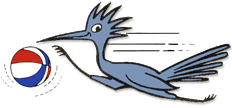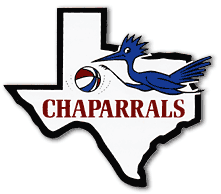

  |
Dallas Chaparrals2012 NBA/ABA Throwback Uniforms -
|
Back to "Remember the ABA" Main Page
Did you see a Chaps game? Or, did you have a favorite Chaps player? Contribute to this web page by
The Dallas Chaparrals always hovered near the middle of the ABA pack. Around the league, the Chaps were known for the vast wealth of their ownership group. Conservative estimates placed the net worth of the group (including Bob Folsom) at around $750,000,000. While the Dallas owners had money, they refused to spend it on their basketball team. The Chaps rarely, if ever, signed any of their high draft picks (in fact, the best draft "find" in Dallas franchise history, Ron Boone, was a relatively unknown eighth round pick).
In the ABA's inaugural season, the Chaps had the fourth best record in the league and finished second in the Western Division. They crushed the hapless Houston Mavericks in the first round of the playoffs, but then easily succumbed to the New Orleans Buccaneers in the Western Division Finals. The chief reason for the team's early success was player-coach Cliff Hagan, the former NBA All-Star with the St. Louis Hawks. Hagan's physical style was perfect for the early ABA, and he averaged 18.2 points per game that first year. Early on, Dallas' best player was Bob Verga. Verga was near the top of the league in scoring, at more than 23 points per game, when he was called away for military duty. He only played 31 games for Dallas in 1967-68. He was picked as a member of the 1st ABA All-Star Team, but couldn't play in the All-Star game because of his military commitment. The biggest surprise for the Chaps was center John Beasley. He averaged 19.7 points per game the first year. Another surprise was guard Charlie Beasley (no relation to John), who led the ABA in foul shooting with an 87% average.
|
|
In a game played early in the ABA's inaugural season, the Dallas Chaparrals host the Denver Rockets in front of a sparse crowd. (Photo Copyright © John Oznick and used with permission) |
The Chaps' second season was not a memorable one as the team finished fourth in the Western Division. Before the season, many observers expected seven foot rookie center John Smith, out of Southern Colorado, to help the team offensively. While Smith was an effective rebounder, he struggled on offense. Much of the scoring burden fell on Cincy Powell and John Beasley (who won the MVP award at the 1969 All-Star Game). The major bright spot was rookie phenom Ron Boone. Boone had attracted almost no attention during his college career at Idaho State, but blossomed in the pro game. He was a strong rookie of the year candidate and barely lost the award to Warren Armstrong of Oakland. Rookie Glen Combs also shined, averaging 15.4 ppg. His most noticeable statistic was a gaudy .361 three point field goal percentage.
Dallas' third season was also a disappointment. The team struggled early on as enforcer Cincy Powell suffered both a broken jaw and a sprained ankle. Hagan's coaching style also began to grate on his players and team management. Some Dallas players hated playing for Hagan because he was a "screamer." Chaps management felt that what the team needed was more encouragement, rather than constant yelling and screaming. Hagan was fired in January 1970, and General Manager Max Williams took over the team. The team improved a little after Williams took over (it averaged an impressive 128 points per game), and finished in second place behind Denver. Glen Combs probably was the team's MVP, averaging 22.2 ppg. In the playoffs however, Dallas was upset in the first round by the surprising Los Angeles Stars.
|
|
|
Former St. Louis Hawk and Hall-of-Famer Cliff Hagan (right) had very little patience for ABA referees, and almost no patience with his own players. During the 1969-70 season, Chaps management felt that Hagan's abrasive coaching style had demoralized the team. The front office fired him and replaced him with GM Max Williams. (Photos Copyright © John Oznick and used with permission) |
|
For the 1970-71 season, Chaps management tried its greatest experiment--regionalization. The name of the team was changed to the "Texas" Chaparrals. While Texas still played most of its games in Dallas, the team also played in Lubbock and Fort Worth. This experiment fizzled in a dramatic way. While the crowds in Dallas remained strong, attendance in Fort Worth and Lubbock steadily declined over the season. The breaking point came on January 5, 1971, when less than 200 fans showed up in Forth Worth to see the Chaps play the Pittsburgh Condors (the crowd was actually announced as 500). Management promptly canceled the last five games scheduled for Fort Worth and switched them to Dallas. On the court, the team lacked direction and confidence -- team leader John Beasley had been traded. Rookies Rich Jones and Joe Hamilton showed promise, but could not carry the team. Most of the season, Texas engaged in a nip and tuck battle with Denver for the last playoff spot in the Western Division. General Manager Max Williams watched his team struggle in last place early in the season before he finally decided to fire himself. He gave up the coaching position to Bill Blakeley, who promptly lost two games in a row for the first time in his 13 year head coaching career. In the middle of the season, the team made a trade which it would live to regret -- it sent Ron Boone and Glen Combs to Utah for a disgruntled Donnie Freeman and a banged-up Wayne Hightower. Observers first thought that Texas got the better deal--but soon changed their minds as Boone and Combs became important elements of Utah's 1971 championship team. In fact, after Texas nipped the Denver Rockets in a one-game playoff for the final playoff spot in the Western Division, Boone and Combs led Utah past Texas in four straight games.
|
|
|
In their early years, the Chaps had the extremely potent guard combination of Ron "Iron Man" Boone (left) and Glen Combs (right). Unfortunately, the Chaps traded these two young players to the Utah Stars in the middle of the 1970-71 season and never quite recovered. (Photos Copyright © John Oznick and used with permission) |
|
For the next season, the team "returned" to Dallas and played all of its games there. Their new young coach was Tom Nissalke, the former assistant coach of the NBA's Milwaukee Bucks. Nissalke got the most out of his players (including the talented Rich Jones and Joe Hamilton) and managed to guide the team to a .500 record and third place in the Western Division. For his efforts, Nissalke won the ABA Coach of the Year award. However, Dallas was once again swept by Utah in four straight games in the first round of the playoffs.
Strangely, the team declined to hang on to Nissalke. Nissalke promptly found a new head coaching job with the Seattle Supersonics of the NBA. The Chaps' latest coach was Babe "Magnolia Mouth" McCarthy. Unfortunately, the team floundered under McCarthy, and the respected coach was fired. The Chaps finished with only 28 wins, 2 games behind the ABA's new expansion team, the San Diego Conquistadors. For the first time in their existence, the franchise failed to make the playoffs. It was also the last season for the team in Dallas, as the owners decided to lease the team to Angelo Drossos in San Antonio for the 1973-74 season. The team became the San Antonio Spurs, and eventually stayed in that city under the ownership of Drossos.
Chaps 1968-70 Home Uniform |
Chaps 1968-70 Road Uniform |
Chaps 1972-73 Home Uniform |
Chaps 1972-73 Road Uniform |
1967-68 Dallas Chaparrals
Record: 46-32, Second Place in Western Division
1968 Playoff Results:1968 Western Division Semifinals vs. Houston Mavericks (29-49)
Chaps won series, 3-01968 Western Division Finals vs. New Orleans Buccaneers (48-30)
New Orleans won series, 4-1
Record: 41-37, Fourth Place in Western Division
1969 Playoff Results1969 Western Division Semifinals vs. New Orleans Buccaneers (46-32)
New Orleans won series, 4-3
Record: 45-39, Second Place in Western Division
1970 Playoff Results:1970 Western Division Semifinals vs. Los Angeles Stars (43-41)
Stars won series, 4-2
Record: 30-54, Fourth Place in Western Division
1971 Playoff Results:One Game Playoff at Denver for Fourth Place and Playoff Spot vs. Denver Rockets (30-54)
Chaps won 115-1091971 Western Division Semifinals vs. Utah Stars (57-27)
Utah won series, 4-0
Record: 42-42, Third Place in Western Division
1972 Playoff Results:1970 Western Division Semifinals vs. Utah Stars (60-24)
Utah won series, 4-0
Record: 28-56, Fifth Place in Western Division
Missed Playoffs